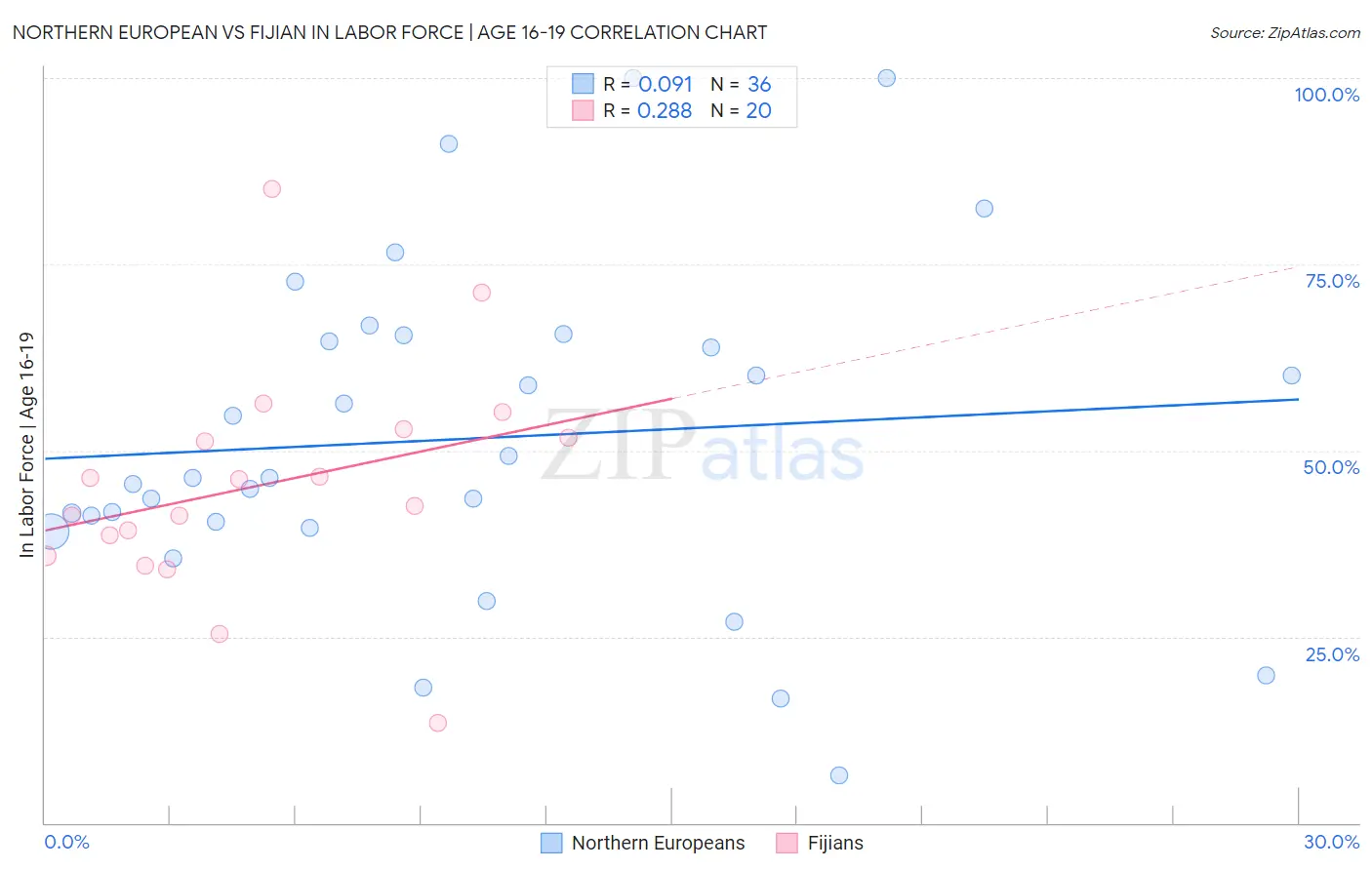Northern European vs Fijian In Labor Force | Age 16-19
COMPARE
Northern European
Fijian
In Labor Force | Age 16-19
In Labor Force | Age 16-19 Comparison
Northern Europeans
Fijians
40.2%
IN LABOR FORCE | AGE 16-19
100.0/ 100
METRIC RATING
63rd/ 347
METRIC RANK
40.4%
IN LABOR FORCE | AGE 16-19
100.0/ 100
METRIC RATING
56th/ 347
METRIC RANK
Northern European vs Fijian In Labor Force | Age 16-19 Correlation Chart
The statistical analysis conducted on geographies consisting of 405,208,027 people shows a slight positive correlation between the proportion of Northern Europeans and labor force participation rate among population between the ages 16 and 19 in the United States with a correlation coefficient (R) of 0.091 and weighted average of 40.2%. Similarly, the statistical analysis conducted on geographies consisting of 55,922,250 people shows a weak positive correlation between the proportion of Fijians and labor force participation rate among population between the ages 16 and 19 in the United States with a correlation coefficient (R) of 0.288 and weighted average of 40.4%, a difference of 0.56%.

In Labor Force | Age 16-19 Correlation Summary
| Measurement | Northern European | Fijian |
| Minimum | 6.4% | 13.4% |
| Maximum | 100.0% | 85.1% |
| Range | 93.6% | 71.7% |
| Mean | 51.6% | 45.4% |
| Median | 46.3% | 44.4% |
| Interquartile 25% (IQ1) | 40.1% | 37.2% |
| Interquartile 75% (IQ3) | 65.1% | 52.2% |
| Interquartile Range (IQR) | 25.0% | 15.0% |
| Standard Deviation (Sample) | 22.1% | 15.4% |
| Standard Deviation (Population) | 21.8% | 15.0% |
Demographics Similar to Northern Europeans and Fijians by In Labor Force | Age 16-19
In terms of in labor force | age 16-19, the demographic groups most similar to Northern Europeans are Cherokee (40.2%, a difference of 0.060%), Immigrants from Micronesia (40.2%, a difference of 0.12%), Kenyan (40.1%, a difference of 0.19%), American (40.3%, a difference of 0.20%), and Nonimmigrants (40.1%, a difference of 0.32%). Similarly, the demographic groups most similar to Fijians are Lithuanian (40.4%, a difference of 0.030%), Aleut (40.4%, a difference of 0.040%), British (40.5%, a difference of 0.090%), Tlingit-Haida (40.5%, a difference of 0.12%), and Immigrants from Kenya (40.5%, a difference of 0.15%).
| Demographics | Rating | Rank | In Labor Force | Age 16-19 |
| Cree | 100.0 /100 | #49 | Exceptional 40.8% |
| Indonesians | 100.0 /100 | #50 | Exceptional 40.7% |
| Immigrants | Zaire | 100.0 /100 | #51 | Exceptional 40.7% |
| Immigrants | Laos | 100.0 /100 | #52 | Exceptional 40.6% |
| Immigrants | Kenya | 100.0 /100 | #53 | Exceptional 40.5% |
| Tlingit-Haida | 100.0 /100 | #54 | Exceptional 40.5% |
| British | 100.0 /100 | #55 | Exceptional 40.5% |
| Fijians | 100.0 /100 | #56 | Exceptional 40.4% |
| Lithuanians | 100.0 /100 | #57 | Exceptional 40.4% |
| Aleuts | 100.0 /100 | #58 | Exceptional 40.4% |
| Slavs | 100.0 /100 | #59 | Exceptional 40.4% |
| Immigrants | Eastern Africa | 100.0 /100 | #60 | Exceptional 40.4% |
| Americans | 100.0 /100 | #61 | Exceptional 40.3% |
| Cherokee | 100.0 /100 | #62 | Exceptional 40.2% |
| Northern Europeans | 100.0 /100 | #63 | Exceptional 40.2% |
| Immigrants | Micronesia | 100.0 /100 | #64 | Exceptional 40.2% |
| Kenyans | 100.0 /100 | #65 | Exceptional 40.1% |
| Immigrants | Nonimmigrants | 100.0 /100 | #66 | Exceptional 40.1% |
| Canadians | 100.0 /100 | #67 | Exceptional 40.1% |
| Italians | 99.9 /100 | #68 | Exceptional 40.1% |
| Potawatomi | 99.9 /100 | #69 | Exceptional 40.0% |